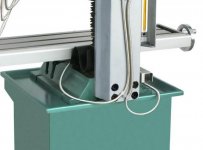New to machining and this forum.
I have a grizzly G0759 mill with a DRO and have found it pretty difficult to get a good chamfer centered on a drill hole.
I'll drill a hole, and not move the bed at all, only swap from the drill bit to a chamfer bit. When I cut the chamfer, it'll be quite a bit off center, which is really annoying.
I also ran into this issue when I was drilling a 82* counter sink.
Any ideas/suggestions on what might be going wrong?
Thanks.
I have a grizzly G0759 mill with a DRO and have found it pretty difficult to get a good chamfer centered on a drill hole.
I'll drill a hole, and not move the bed at all, only swap from the drill bit to a chamfer bit. When I cut the chamfer, it'll be quite a bit off center, which is really annoying.
I also ran into this issue when I was drilling a 82* counter sink.
Any ideas/suggestions on what might be going wrong?
Thanks.



 ]
]